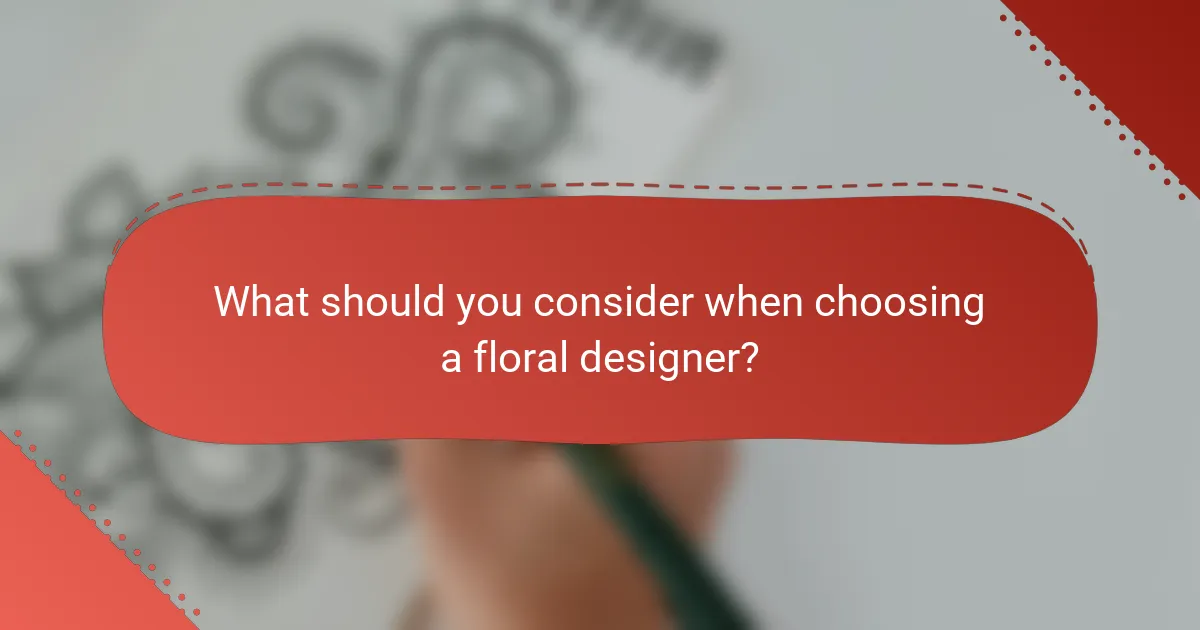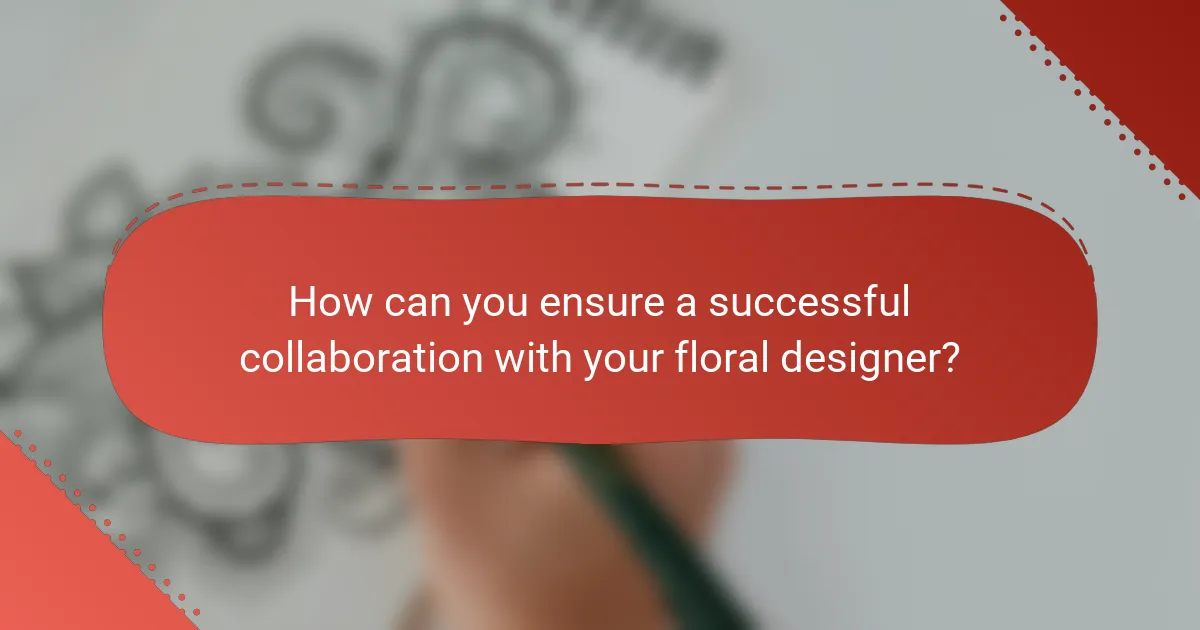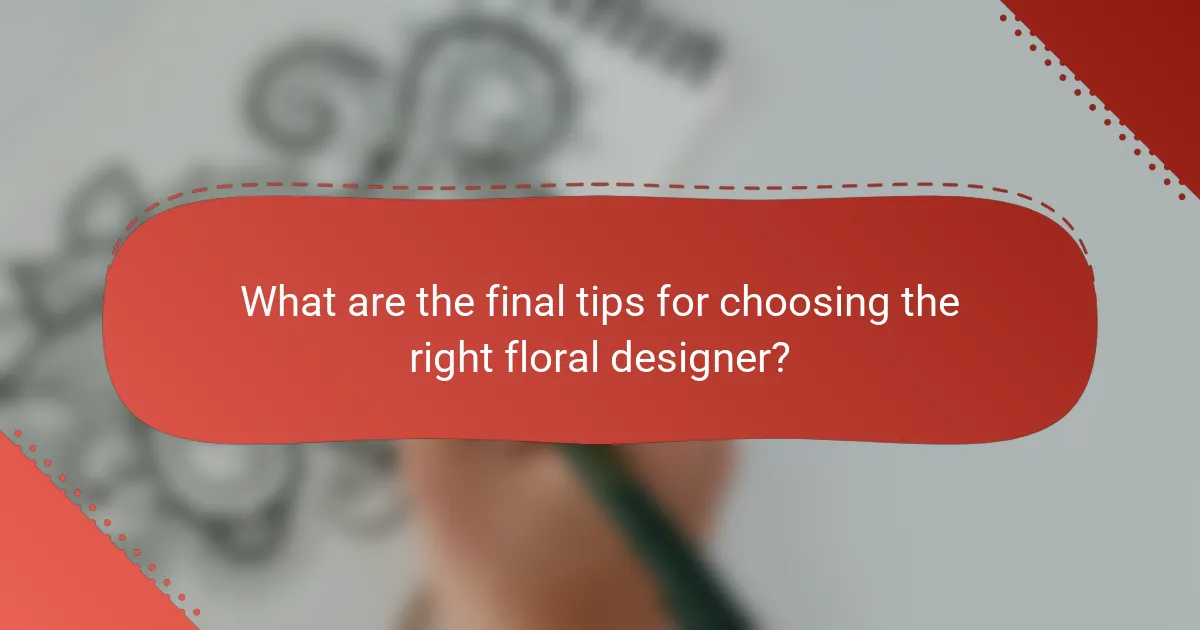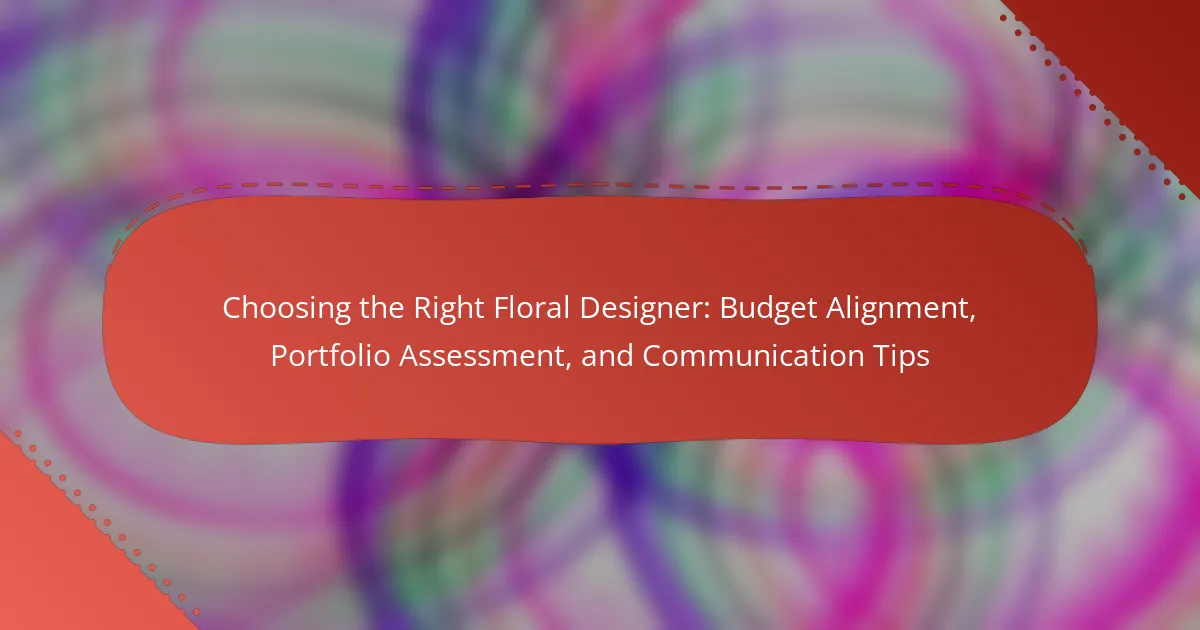
What should you consider when choosing a floral designer?
When choosing a floral designer, consider their portfolio and style. Review their previous work to ensure it aligns with your vision. Assess their experience with your specific event type, such as weddings or corporate functions. Evaluate their pricing structure to ensure it fits your budget. Communication is crucial; ensure they are responsive and understand your needs. Check reviews or testimonials from past clients for reliability. Finally, confirm their availability for your event date to avoid scheduling conflicts.
How does budget alignment impact your choice of floral designer?
Budget alignment significantly impacts your choice of floral designer. It determines which designers are financially viable for your event. A clear budget helps filter options based on cost-effectiveness. Designers often have varying price points for their services and materials. Understanding your budget can lead to better negotiations and value assessments. It also ensures that you can afford the desired floral arrangements without compromising quality. Ultimately, budget alignment directly influences the selection process, narrowing down choices to those that fit within financial constraints.
What are the typical budget ranges for floral design services?
Typical budget ranges for floral design services vary widely. Basic arrangements can start at $50 to $150. Mid-range services often cost between $150 to $500. High-end floral design can exceed $500, reaching up to $2,000 or more for elaborate setups. These prices depend on factors like event size, flower types, and designer experience. For example, weddings generally require larger budgets compared to corporate events. According to industry reports, the average wedding floral budget is around $1,500.
How can you determine your floral design budget?
To determine your floral design budget, start by assessing your overall event budget. Allocate a specific percentage for floral arrangements, typically ranging from 10% to 15% of the total budget. Next, identify your floral needs, including types of flowers, arrangements, and venue size. Research average costs for floral services in your area to establish a baseline. Consult with multiple floral designers to gather quotes and compare services. Finally, prioritize your floral elements based on importance and adjust your budget accordingly. This structured approach ensures that you align your floral design choices with your financial capabilities.
Why is portfolio assessment important in selecting a floral designer?
Portfolio assessment is important in selecting a floral designer because it showcases their style and expertise. A designer’s portfolio reflects their previous work and creativity. It allows potential clients to evaluate the quality and uniqueness of their designs. Reviewing a portfolio helps identify if the designer’s aesthetic aligns with the client’s vision. It also provides insight into the designer’s experience with different floral arrangements and event types. A strong portfolio often indicates a designer’s reliability and skill level. This assessment is crucial for making an informed decision when hiring a floral designer.
What key elements should you look for in a floral designer’s portfolio?
Key elements to look for in a floral designer’s portfolio include diversity of styles, quality of craftsmanship, and creativity in arrangements. A diverse portfolio showcases the designer’s ability to handle various themes and occasions. Quality craftsmanship is evident in the execution of floral arrangements, reflecting attention to detail. Creativity can be assessed through unique designs and innovative use of materials. Additionally, client testimonials and photos of past events provide context and validation of the designer’s skills. A well-rounded portfolio should also highlight the designer’s ability to work within different budgets and settings.
How can you assess the style and creativity of a floral designer through their portfolio?
To assess the style and creativity of a floral designer through their portfolio, examine the variety of arrangements showcased. Look for unique compositions that reflect innovative use of colors and textures. Note the designer’s ability to create cohesive themes across different types of events. Consider the quality of photography, as well-executed images enhance the visual appeal of the work. Check for a range of floral types and arrangements, indicating versatility. Review client testimonials included in the portfolio for insights into the designer’s creativity and reliability. Lastly, observe how the designer adapts their style to different occasions, showcasing their flexibility and artistic vision.
What role does communication play in the designer-client relationship?
Communication is essential in the designer-client relationship. It facilitates understanding of client needs and expectations. Clear communication helps designers translate ideas into tangible designs. Regular updates prevent misunderstandings and ensure alignment throughout the project. Effective communication builds trust between the designer and the client. Studies show that projects with strong communication have higher satisfaction rates. This relationship ultimately influences the success of the design outcome.
How can effective communication enhance your floral design experience?
Effective communication enhances your floral design experience by ensuring clarity and understanding between you and the designer. Clear communication helps articulate your vision, preferences, and budget constraints. It allows the designer to grasp your style and desired outcomes accurately. When you share specific details, such as color schemes and flower types, the designer can tailor their work to meet your expectations. Additionally, open dialogue fosters collaboration, enabling adjustments and refinements throughout the design process. Research shows that effective communication in creative projects leads to higher satisfaction rates among clients. In the floral design context, this translates to a more personalized and successful outcome.
What questions should you ask a floral designer during initial consultations?
What questions to ask a floral designer include inquiries about their experience, design style, and availability. Ask about their previous work and request to see a portfolio. Inquire about their approach to floral arrangements and whether they can accommodate your vision. Discuss your budget and ask for a detailed breakdown of costs. Confirm if they have liability insurance and what their cancellation policy is. Lastly, ask about delivery and setup services on the event day. These questions help ensure a successful collaboration and alignment with your expectations.

How can you ensure a successful collaboration with your floral designer?
To ensure a successful collaboration with your floral designer, establish clear communication from the start. Discuss your vision, preferences, and budget openly. Providing a detailed brief helps the designer understand your needs. Schedule regular check-ins to discuss progress and address any concerns. Be open to the designer’s suggestions, as they have expertise in floral arrangements. Trust their creative input while ensuring your ideas are incorporated. Document all agreements regarding timelines and costs to avoid misunderstandings. A successful collaboration relies on mutual respect and understanding throughout the process.
What steps can you take to establish clear expectations?
To establish clear expectations, communicate specific goals and requirements. Define the project scope, including deadlines and budget. Discuss desired styles and floral arrangements in detail. Share visual references to illustrate your vision. Schedule regular check-ins to monitor progress and address concerns. Document all agreements in writing for clarity. Ensure both parties understand their roles and responsibilities. This approach minimizes misunderstandings and aligns efforts for successful outcomes.
How can you articulate your vision to your floral designer?
To articulate your vision to your floral designer, clearly describe your preferences and ideas. Use visual aids like mood boards or photos for reference. Specify colors, flower types, and styles you envision. Discuss the event’s theme and atmosphere you want to create. Share any personal stories or meanings behind your choices. This approach ensures the designer understands your vision. Effective communication leads to a successful floral arrangement. Research shows that clear client-designer communication improves satisfaction rates in event planning.
What are the best practices for providing feedback during the design process?
Best practices for providing feedback during the design process include being specific, timely, and constructive. Specific feedback helps designers understand what works and what needs improvement. Timely feedback allows for adjustments to be made while the project is still in progress. Constructive criticism focuses on solutions rather than just pointing out flaws. Additionally, using visual references can clarify your feedback. Encouraging open dialogue fosters collaboration and understanding. Finally, acknowledging positive aspects of the design can motivate designers and enhance the working relationship. These practices lead to more effective communication and better design outcomes.
How can you navigate potential challenges with your floral designer?
To navigate potential challenges with your floral designer, establish clear communication from the outset. Discuss your vision and expectations in detail. Provide examples of floral arrangements you admire. This will help the designer understand your preferences. Set a realistic budget early in the planning process. This ensures both parties are aligned on financial expectations. Regular check-ins during the planning phase can prevent misunderstandings. Address any concerns promptly to maintain a positive working relationship. Document agreements in writing to avoid confusion later. This practice provides a reference point for both parties.
What common issues arise in floral design projects, and how can you address them?
Common issues in floral design projects include poor communication, budget overruns, and flower availability. Poor communication can lead to misunderstandings about client expectations. To address this, maintain clear and frequent communication with clients throughout the project. Budget overruns often occur due to unforeseen costs. To prevent this, establish a detailed budget and include a contingency plan for unexpected expenses. Flower availability can be a challenge, especially for seasonal blooms. To mitigate this issue, discuss alternative options with clients early in the process. These strategies help ensure a smoother floral design project experience.
How can you manage changes in your floral design plan effectively?
To manage changes in your floral design plan effectively, establish clear communication with your floral designer. This ensures that any modifications align with your vision and budget. Regularly review the design elements to identify areas that may require adjustments. Utilize visual aids, such as mood boards, to clarify your preferences. Setting a flexible timeline can accommodate any unexpected changes. Document all agreed-upon changes to maintain a clear record. This approach minimizes misunderstandings and keeps the project on track. Effective management of changes leads to a successful floral design outcome.

What are the final tips for choosing the right floral designer?
Evaluate the floral designer’s portfolio for style and creativity. Look for designs that resonate with your vision. Check reviews to gauge customer satisfaction and reliability. Confirm their availability for your event date. Discuss your budget openly to ensure alignment. Ask about their experience with similar events. Inquire about their sourcing practices for flowers. Ensure clear communication throughout the planning process.
What key takeaways should you remember when selecting a floral designer?
When selecting a floral designer, consider their portfolio, communication style, and budget alignment. A strong portfolio showcases the designer’s creativity and style. Review past work to ensure it matches your vision. Effective communication is essential for articulating your needs and preferences. Discuss your budget upfront to avoid misunderstandings. Check client reviews for insights into their reliability and professionalism. Ensure the designer is familiar with your event type for tailored arrangements. Confirm their availability on your event date to secure their services.
How can you evaluate whether you’ve made the right choice in a floral designer?
To evaluate whether you’ve made the right choice in a floral designer, assess their portfolio and client feedback. A strong portfolio showcases a variety of styles and successful events. Client testimonials provide insight into the designer’s reliability and quality. Compare their work to your vision and expectations. Ensure their designs align with your budget. Effective communication is crucial for understanding your needs. If the designer is responsive and attentive, it indicates a good fit. Additionally, confirm they have experience with your specific event type. This comprehensive assessment will help determine if you made the right choice.
What resources can assist you in your search for the perfect floral designer?
Online directories can assist you in your search for the perfect floral designer. Websites like The Knot and WeddingWire feature listings of floral designers along with reviews. Social media platforms such as Instagram and Pinterest showcase designers’ portfolios. Local wedding expos and bridal shows provide opportunities to meet designers in person. Referrals from friends and family can lead to trusted designers. Additionally, floral design associations offer directories of certified professionals. Reading blogs about floral design can provide insights and recommendations. Each resource helps narrow down options based on style and budget.
The main entity of this article is floral designers, focusing on key aspects such as budget alignment, portfolio assessment, and effective communication. The article provides guidance on selecting the right floral designer by emphasizing the importance of reviewing portfolios to ensure stylistic compatibility, understanding budget ranges for floral services, and maintaining clear communication to articulate needs and preferences. It also outlines strategies for establishing expectations, managing changes, and addressing common challenges in the floral design process. Overall, the article serves as a comprehensive resource for individuals seeking to navigate the selection process for floral design services.
